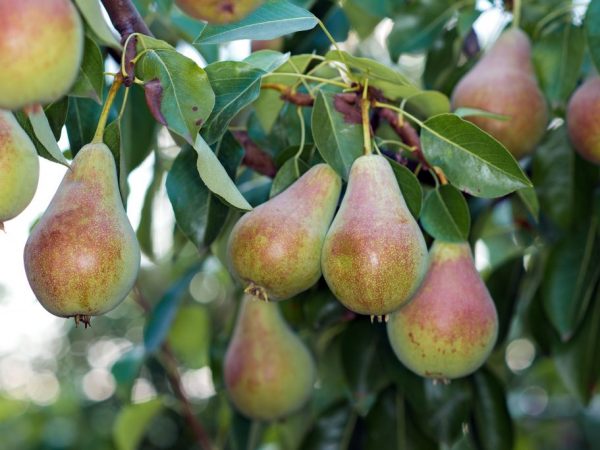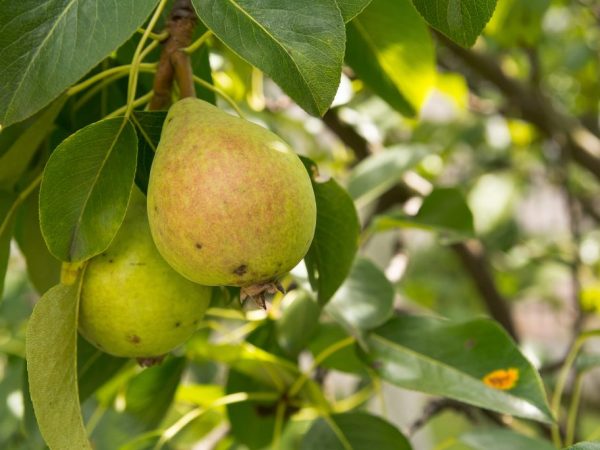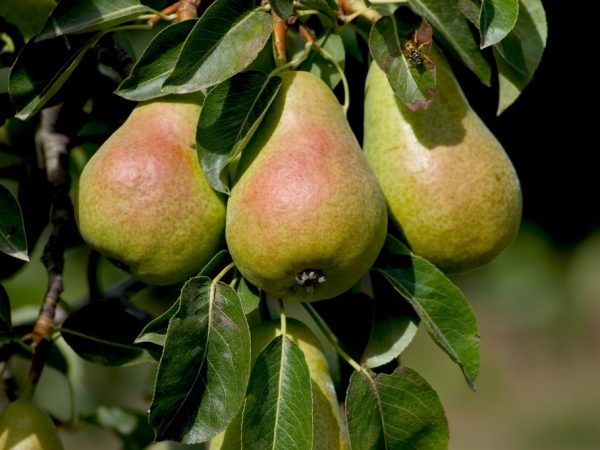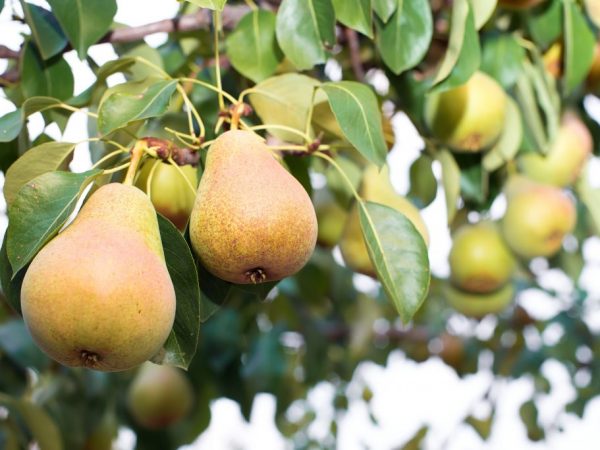Popular varieties of pears
It is difficult to determine the best pear variety. There are a huge number of hybrids on the market, each of which has its own merits. When buying seedlings, pear varieties are chosen that are cultivated in a specific region. It will take a long time to describe all varieties of pears that give a good harvest. Let's focus on the most popular ones.
- Permyachka
- Growing features
- Exhibition
- Growing features
- Bere Moskovskaya
- Growing features
- Augustine
- Growing features
- Delight
- Growing features
- Tyutchevskaya
- Growing features
- Lucas
- Growing features
- Deccan du Comis
- Growing features
- Talitsa
- Growing features
- Muratovskaya
- Growing features
- Platonovskaya
- Growing features
- Zolotovorotskaya
- Growing features
- Patten
- Growing features
- Topic
- Growing features
- Summer, autumn and winter varieties
- Other features of varieties
- Conclusion

Popular varieties of pears
Permyachka
Perm is a tall variety of pears that produces large fruits. The crown has a rounded shape. The average weight of a ripe fruit is 150 g. In productive years, fruits weighing 270 g are formed. The average yield is 30 kg. Under unfavorable conditions, the pear is small and hard.
On the surface of the fruit, which is shaped like a cone, ribbing is pronounced, there are tubercles. The rind is colored yellow with orange circles resembling blush. The inside of the fruit is white. The structure of the juicy pulp is fine-grained. Perm has no sour taste. The crop ripens in late summer or early spring.
Growing features
Pear variety Permyachka is not self-pollinated. It is planted next to pollinators, which are used as other varieties of pears or fruit trees. An excellent pollinator is the Jeanne Dark hybrid. Also, insects are attracted to the site, which pollinate the plants.
For planting, choose 2-year-old seedlings. Fortified plants are planted both in autumn and spring. A tall hybrid bears fruit in 2-3 years after planting.
Exhibition
Hybrid variety of pear Vystavochnaya is the result of the work of breeders from Moldova. The advantage of a late-ripening hybrid is large-fruited. The average weight of a ripe fruit with an asymmetric shape varies from 250 to 300 g. The exhibition pear is not small, but not large either. On its surface, there are tubercles and ribbing. The thin, glossy rind is yellow-green with a slight blush.
The hybrid is appreciated for its juicy and sweet pulp, colored white with a creamy shade, it has a sweet and sour taste.
Growing features
The hybrid is winter hardy and suitable for growing in almost any region of the country. It is resistant to some diseases, for example, to scab, but preventive treatments are still needed.
Bere Moskovskaya
The pear variety Bere Moskovskaya is medium-sized. Its crown takes on the shape of a ball during formation. Fruit weight is 90-100 g. Fruiting is amicable and stable. The skins of asymmetrical fruits are light yellow; red blush is not always present.Juicy buttery pulp with a sweet and sour taste is colored white. Fruit ripening occurs at the beginning of autumn.
Growing features
Bere Moskovskaya is easy to care for. It is resistant to rot, scab and other diseases affecting fruit crops. The hybrid is frost resistant. The harvest is harvested before the skin of the fruit turns yellow. After harvest, they give 4-5 days for ripening.
The disadvantage of this pear variety is the short storage period. Fruits are stored in a cold place for no more than 1.5 months.
Augustine

Fruits can be stored for a long time
The Augustinka hybrid has a good keeping quality. A medium-sized type of pear grows to a height of no more than 3 m. The crown is most often formed in the form of a wide pyramid. The formation of the crown less often occurs in the form of a ball.
The fruits, wide at the base, weigh from 250 to 400 g. Their average yield is 30 kg. The rind is yellow, with a crimson blush. Juicy white pulp has a fine-grained structure, medium density. According to the description, the fruit has a sourness and nutmeg aroma.
Growing features
This pear variety begins to bear fruit in the 5th year after planting. The medium-sized Augustinka is resistant to all diseases affecting fruit crops, and tolerates temperature changes well. When planting, choose the western, southwestern or southern part of the site. In the northern and northwestern parts of the garden, the hybrid does not grow well. This is due to the fact that Augustine is a light-loving plant.
The hybrid is self-pollinating, but with pollinators nearby, yields increase.
Delight
The pear variety Uslada is valued for its high frost resistance and keeping quality. Ripe fruits are stored for 70-75 days. The weight of uniform fruits of a round or rounded-conical shape varies from 150 to 170 g. This is far from the best yield inherent in hybrids, but Uslada gives a stable harvest regardless of climatic conditions.
There is no ribbing on the fruit. The smooth skin is colored green-yellow with a red blush. Subcutaneous points are pronounced. The rough skin covers the white juicy pulp with a sweet and sour taste.
Growing features
A semi-dwarf tree forms a compact crown during growth, which makes it possible to plant seedlings next to each other. Frost resistance allows you to grow a hybrid even in the northern regions.
Tyutchevskaya
Tyutchevskaya pear is an early autumn hybrid. Tall trees have an oval crown. The weight of ripe fruits is 130-150 g. When harvested, the skin of medium density is colored green. In 2-4 days after harvest, the skin turns yellow, which indicates full ripening of the fruit.
The fruit has a slight blush and green subcutaneous spots. The dense juicy pulp is white with a greenish tinge, the structure is fine-grained. The taste is sweet, sourness is present. Fruit retains its presentation during transportation.
Growing features
The hybrid is recommended for cultivation in the central and southern parts of the country. It does not differ in frost resistance, therefore, in the northern regions it gives a poor harvest and is often sick. The hybrid is scab resistant.
Lucas
Lucas hybrid obtained by French breeders. The pulp of the fruit has a weight of 150-200 g, it is fine-grained and harsh. Fruits are suitable for canning and making sweet dishes. The thin peel of a tasty but tart pear is greenish-yellow in color, there are numerous subcutaneous points. The shape of the fruit is pear-shaped, the blush is point-like. The hybrid is appreciated for keeping quality.
Growing features

The tree needs to be well looked after
Lucas is suitable for growing in warm climates. It is not resistant to many diseases, so preventive treatments must be carried out.Another variety is affected by parasitic insects, the most dangerous of which is the pear caterpillar (pear peacock eye). With proper care, the fruit crop produces a stable harvest.
Deccan du Comis
From the name of the pear variety, it is easy to determine its French origin. A medium-sized tree produces aromatic pears, which are appreciated for their high taste. Sweet fruits have an oval-oblong shape, which is unusual for this culture. Fruit weight varies from 180 to 250 g. Thin skin with numerous subcutaneous punctures is yellow, with a red-orange blush. The texture of the juicy pulp, colored white, creamy. In a cold place, the shelf life of fruits is 5-6 months.
To improve the taste of the culture, it is grafted onto quince.
Growing features
The Comis hybrid needs a warm climate and a lot of moisture, which makes it difficult to care for the fruit crop. At a temperature of 30 ° C and below, the tree dies. Fruit culture is not exposed to scab; other diseases are treated with preventive treatments. The Comis hybrid needs pollinators.
Talitsa
Talitsa is a hybrid of domestic selection, the advantage of which is a high growth rate. It belongs to the pyramidal varieties of pears, it needs crown formation. Pears of this variety are small. Their average weight is 90 g.
The fruits are not pear-shaped, but apple-shaped, there is no ribbing and tuberosity. The dense skin is light yellow, there is no blush. Large subcutaneous points are pronounced. The fruit has an interesting sweet and sour taste that includes honey notes.
Growing features
Talitsa is frost-resistant. Ripe fruits must be harvested. The ripening period falls in mid-August. If not harvested on time, the crop begins to crumble. The hybrid gives the first crop at the age of 5 years. Talitsa is highly scab resistant and moderately resistant to spotting.
Muratovskaya
A popular variety of pears is Muratovskaya, bred by domestic breeders. A medium-sized tree has a pyramidal shape. The weight of pear-shaped fruits varies from 120 g to 140 g. Ribbing is present.
Delicate thin skin, covering the fragrant pulp, is yellow in color with a golden sheen. During technical maturity, it has a green-yellow color. There is a slight blush and thin longitudinal red stripes. The creamy pulp has a sweet and sour taste.
Growing features
A distinctive feature of the Muratov hybrid is early maturity. He has an average resistance to disease. With proper care, it gives a good harvest even in lean years.
Platonovskaya

The variety is appreciated for its taste.
Platonic pear is an early autumn domestic hybrid. The weight of small fruits, covered with a green-yellow smooth, dense skin, varies from 160 to 250 g. The shape of delicious pears of this variety is apple-shaped, with ribbing. If the sun falls on the fruit during ripening, a slight blush appears. The juicy, aromatic pulp with a creamy texture is appreciated for its taste. The hybrid is classified as a dessert variety.
Growing features
The hybrid is frost-resistant and immune to many diseases. It is undemanding to soils. To get high yields, the plant should be fertilized annually.
Platonic pear begins to bear fruit 3 years after planting.
Zolotovorotskaya
Golden Rotary Pear is a winter hybrid derived from wild pear and quince. In height, Zolotovorotskaya grows up to 4 m. Accordingly, it is a medium-sized garden culture. The advantage of the Zolotovorskaya pear variety is its early maturity. The hybrid gives the first crop 3-4 years after planting. The culture bears fruit for 18-20 years.
Large bergamot-shaped fruits have juicy sweet and sour pulp.There is an almond flavor.
Fruit weight - from 240 to 330 g. After ripening, the green color of the thin, smooth peel turns into light yellow. There are pronounced subcutaneous points. The texture of the pulp is creamy. Zolotovorskaya pear loses to other hybrids in terms of such characteristics as its presentation, but it tolerates transportation well.
Growing features
Zolotovorskaya pear belongs to frost-resistant varieties. The hybrid needs fertile soils. He is picky about humidity and sunlight. It is grown in the central part of Russia. The tree needs shaping and thinning.
Patten
Patten is a hybrid of American selection. The advantage of the Patten pear variety is its early maturity. Seedlings give their first harvest 4 years after planting. The hybrid is medium-sized. Fruit weight is 200-300 g. Fruit is leveled, has a standard pear-shaped shape, ribbing is absent.
The juicy pulp of the pear is covered with a glossy yellow skin. At the stage of technical maturity, the color of the rind of medium density is yellow-green. There is a slight blush on the sides of the fruit. There are small subcutaneous points. The pulp is fragrant, there is no sourness.
Growing features

The variety will delight you with its yield
Patten is not a frost-hardy species. It is grown in the suburbs and regions of Russia with a similar climate. The hybrid is scab resistant. It is appreciated for its abundant fruiting and large-fruited
Topic
Tyoma is a domestic hybrid. Its feature is its high growth rate. The tree is tall, the shape can be round or pyramidal. Ripe fruits weigh from 150 to 200 g. With mass fruiting, the weight of the fruit decreases by 50-70 g. The weight of the largest specimens is 390-400 g. Asymmetric fruits are more like apples in shape. The rind is yellow. Fruits in direct sunlight become colorful with a slight orange blush. Subcutaneous points are present.
The pulp is juicy, white, and has a fine-grained structure. Fragrant pears Theme are delicious and sweet, there is a sourness in the taste. The crop is harvested in the first half of September. Fruit is consumed 4-5 days after harvest.
Growing features
This pear is frost-resistant. The crown of the hybrid The theme is medium thickened, therefore it does not need frequent thinning. The hybrid does not get scab, but is often attacked by pests.
Summer, autumn and winter varieties
The types of pears are determined, depending on keeping quality. There are autumn, winter and summer hybrids. According to the description of summer pear varieties, the fruit is suitable for fresh consumption and conservation. They are not suitable for long-term storage. Autumn hybrids are stored for several months, winter ones are decay fruits. They are suitable for long-term storage.
- Of the summer noteworthy are Space, Spring, Melting, Favorite Klappa (Favorite), Irista, Ruddy cedrine, Isolde, Sweet iz Mliyeva, Radiant, Petrovskaya, Early June, July, Imrud Bartlett, Zorka, Duchesse (Duchess, Limon, Trapeznitsa) Veselinka, Tonkovotka Ural, Severyanka red-cheeked, Astrakhan early, Autumn Susova, Julia, Sibiryachka, Ilyinka, Sugar, Lagodnaya, Pervenets, Fairy tale (fairy tale). Melting and Favorite Klappa have excellent taste.
- Of the mid-season autumn, the popular are Silva, Uralochka, Krasnobokaya, Goverla, Guidon, General Leclerc, Samara beauty (bred by specialists from the Zhigulevsky gardens research institute), Vrodliva, Nadezhda of the steppe, Flute, Anna's masterpiece, Elegant Efimova, Selyanka, Lyubushka, Pamyatnaya Efimova, Selyanka , Dobryanka, Wedding, Festival, Nugget, Chusovaya, Margarita Marilya (Margot), Dalikor, Kuyumskaya, Sentyabrina, Deanca du Comis, General Kirponos, Christina, Margarita Marilya, Crimean honey, Potapovskaya, Myth, Saphira, Quiet Don, Dawn, Admiral Gervais, Triumph of Pakgam, Deveaux, Autumn dream, Cupid's daughter, Olga, Forest beauty or Forest queen, Bere Alexandra, Gift to the centenary.
- Winter hybrids are suitable for long-term storage.Popular are the Zest of Crimea, Saratovka, Pass Krassan, Josephine Mechelnaya, New Year's, Striyskaya, Katyusha, Xenia, Amphora, Emerald, Nart, Yuzhanka, Yablunivskaya, Corolla, Kucheryanka, Lyubava, February, Cinderella, Malvina, Natzyania Mliyevskaya Trubetskoy, Raketa, Fieriya, Kyrgyz winter, Yuryevskaya, Saint Germain, Krasnokutskiy gift, Winter cuboid, Snow Queen, Sretenskaya, Maisyan.
There are new hybrids that have not had time to establish themselves on the market. These include Shatlyk (Bashkir selection).
Other features of varieties
A whimsical hybrid to care for is Red Anjou. The skin of its large fruits is colored red, and the blush of the fruit is burgundy. The fruits themselves are unusually fragrant.
A high-yielding variety Nikolai Kruger needs crown formation. Average palatability, but stable yield in the pear variety with the unusual name Emmanuel. The hybrids Vostorg, Berezhnaya, Zamenaya, Jurate, Bulb, Sultan, Bera, Paskhalnaya, Berezhenaya, Pears Nashi (pier Neshi), Rukuba, Yasochka, Lakomka, Tsarskaya, Ostrovityanka, Kuibyshevskaya golden are also distinguished by amicable fruiting and stable yields.
In regions with a cold climate, Taiga pear, Dekabrinka, Autumn Dream, Novella, General Totleben, a hybrid of Somov, Institutskaya, Melitopol juicy give a high yield. The medium-sized garden culture Artemovskaya is well adapted to the climate of Russia. Unpretentious to care for is the Memorable, Willow pear and ordinary.
Of the undersized varieties of pears, the Grand Champion, beautiful Rossoshanskaya, deserve attention. Dwarf pears are fast-growing. They give a harvest already 3-4 years after planting. A dwarf pear of any variety is easier to care for than a medium or tall tree.
The pearl among the undersized pears is the self-pollinating Veles. Of the unusual varieties, the Sekui hybrid (Sekue) attracts attention. Self-pollinated hybrids are easy to grow. The most popular are Rix, Rogneda (fruits have a purple hue), Banquet, Tenderness.
Not all imported seedlings take root in the garden. It is better to buy a seedling grown in a nursery in any region of Russia. As a rootstock for horticultural crops, quince or shaggy pear culture is suitable.
Conclusion
The variety of varieties allows you to choose the one that is ideal for growing in a specific region, climate, soil. The choice of a variety also depends on the personal taste preferences of the gardener and his willingness to properly and timely care for the crop.


